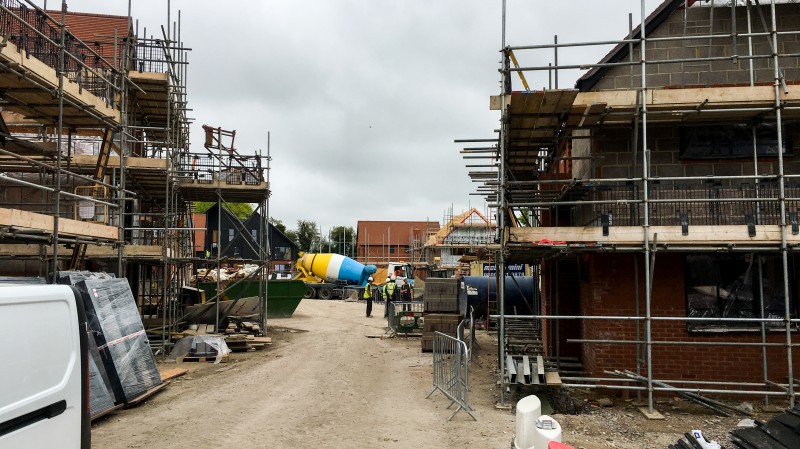You are here: Can a green home be built with concrete?
Concrete often gets a bad rap for being bad for the environment, so is there anything we can do to lessen its impact?
Concrete is the most widely used building material in the planet. It is used in truly vast quantities for building and construction in all parts of the world. Concrete has many advantages but its key ingredient – cement – has a massive carbon footprint. Cement production alone is said to be responsible for about 8% of the world’s CO2 emissions. If the cement industry was a country, it would come after China and the USA as the third largest carbon emitter, according to think tank Chatham House.

How is cement made?
Cement is made by roasting limestone and clay in huge kilns that are heated to about 1,450C and then grinding it into powder to make the artificial stone, known as Portland Cement. In addition to fossil fuels for the kilns, the chemical process which turns the raw materials of limestone and clay into cement releases high levels of CO2.
The environmental impact goes further as the cement binder is added to aggregate (usually gravel or stone) and water to make concrete. Sand and gravel have to be dredged up or quarried, destroying natural habitats and diminishing our supplies of these raw materials. Other virgin materials, mainly limestone and clay, are also quarried and crushed to make cement.
Concrete consumes almost 10% of the world’s industrial water supplies. When we add the amount of steel within reinforced concrete structures and the miles travelled from quarry to building site, it’s easier to understand the harmful impact concrete use has on our planet.
The Pros of concrete:
Concrete is so widely used by architects, structural engineers and builders because it has so many advantages as a building material.
Durable and strong
Concrete is amazingly strong and durable. That’s why billions of homes are built on sturdy concrete foundation. Unlike other types of foundations, concrete doesn’t shift with the movement of soil beneath a building. Concrete walls are exceptionally stable, too.
Compared to other building materials, concrete doesn’t take too kindly to being bent – it has a relatively low tensile strength. That’s the maximum load or stress it can handle before it stretches and breaks. The addition of iron or steel, known as reinforced concrete, greatly increases its tensile strength and allow new uses.
Can be cast to any desired shape
Some of the world’s most iconic buildings owe their form to the material from Sydney Opera House to the Lotus Temple in Delhi. The famous unreinforced domed roof of the Pantheon in Rome has yet to be beaten in size. Architects and contractors use concrete to build homes all over the world. Besides being able to be cast to any desired shape, it’s durable, resistant to wind and water and can withstand high temperatures. Plus, concrete with its high thermal mass contributes to the energy efficiency of buildings.
Extremely long-lasting
It will come as no surprise for a material so strong, that concrete is also long-lasting. For instance, the Pantheon in Rome, which was made using concrete, is still standing today nearly 2,000 years after it was built in 120-124 AD. Concrete can last for hundreds – even thousands of years . Using concrete also makes a building fireproof due to the non-combustible nature of the material. Plus, the maintenance cost of concrete is negligible.
Easily available in most places
Made from a mix of sand, aggregate, a cement binder and water - the ingredients of concrete are widely available in most places. Cement, which gives concrete its bad reputation, only makes up a small proportion of the total – about one sixth. Unlike natural stone, concrete is free from defects and flaws.
Sustainable concrete: can technology make it greener?
Embodied carbon refers to the CO2 emitted during production. Compared with other construction materials, the total impact of concrete production is worse; but that’s because we use so much of it to build bridges, roads, dams, flyovers and in buildings. Concrete has one of the lowest embodied CO2 per kg of any building material – much lower than steel, aluminium or fired clay brick.
The concrete industry has made progress in cleaning up its act with more energy efficient kilns and powered, in some cases, by biomass fuels rather than coal or gas. In the UK, it is relatively easy to find ready-mixed concrete suppliers that use recycled aggregate. If a recycled aggregate, like crushed concrete from a demolition project, is used in the standard 1:6 cement mix, then the resulting concrete will have less impact on the environment compared with conventional concrete made with virgin aggregates. Other waste materials, such as recycled plastic and ash from coal-fired power stations, can also be added to mixture.
Part of the answer to creating more sustainable concrete include the rethinking the way it’s made. For instance, biotech company BioMason, based in North Caroline, uses bacteria that can bind grains of rock and sand together to make concrete. But it’s expensive and not suited to all types of environments. Other promising alternatives include Hempcrete, a composite of natural materials lime and hemp, creating a lightweight concrete. A fast-growing plant that requires little water, one ton of hemp will have absorbed about two tonnes of CO2, so this carbon gain is passed onto the building. Hempcrete can be used for new builds and renovations. It’s suitable for insulating walls, lining, roofs, screeds, attic spaces and render. However, it’s not a load-bearing material, so is cast round a structural frame made of timber, metal or concrete.
Can a green home use concrete?
Concrete is generally locally produced, low-cost and can be made with recycled aggregate. But the facts are too much ordinary concrete – four billion tonnes per year - with all its harmful impact on the environment is still being poured across the globe in vast quantities. Aside from the foundations, there are lots of alternative materials you can choose instead of concrete to extend or renovate your home.
If you are looking to make some home improvements, you may find some of these services useful
Building Regulations
Find details of local experts who can help with Building Regulations
Builders
Find local help with a building project
Architectural Design Services
Find local Architectural Design experts
Structural Inspections
Find an expert to carry out a structural inspection
Building Surveys
I want a local surveyor to do a Building Survey for me
Choose which Architectural service you require
If you are not sure which service you require, check out the options available...


